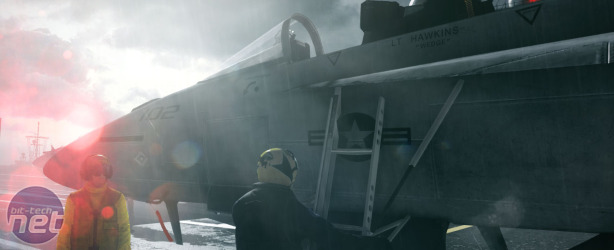
How We Tested
For testing Battlefield 3, we decided to eschew our policy of forcing 16x anisotropic filtering in the driver, in order to fairly compare the game's four graphical presets. We used the most up-to-date AMD and Nvidia graphics drivers available - Catalyst 11.10 and GeForce 285.62 respectively. These were installed with the default settings, and no adjustments made in their 3D settings.For the benchmark itself, we turned to the single-player portion of the game. While we'd have liked to have used a more demanding 64-player multiplayer benchmark, it's remarkably hard to find 63 patient and willing players to perfectly reproduce their actions over 100 times. Instead we opted for a FRAPS-recorded, 90-second scripted sequence at the start of the campaign's fourth mission - Going Hunting.
While it's not perfectly representative of multiplayer gameplay (and lacks graphical details such as landscape decoration), it's still remarkably demanding, and is roughly in line with the performance you'll see in multiplayer mode. It's also very reliable, producing identical results run after run.
Intel Core i7 Test System
- Intel Core i7-965 processor (3.2GHz: 133MHz x 24)
- Asus Sabertooth X58 motherboard (Intel X58 Express with three PCI-E 2.0 x16 slots)
- 3 x 2GB Corsair TR3X6G1333C9 memory modules (operating in triple-channel mode at 1,600MHz 9-9-9-24-1T)
- Corsair X128 120GB SSD running v1 firmware
- Corsair HX1000W PSU
- Windows 7 Home Premium x64
- Antec Twelve Hundred Chassis
Click to enlarge - We use the scripted section at the start of 'Going Hunting' for our BF3 benchmark. It's shiny
AMD Graphics Cards
- AMD Radeon HD 6990 4GB (2 x 830MHz GPUs, 2 x 5GHz memory) using Catalyst 11.10 WHQL
- AMD Radeon HD 6970 2GB (880MHz GPU, 5.5GHz memory) using Catalyst 11.10 WHQL
- AMD Radeon HD 6950 2GB (800MHz GPU, 5GHz memory) using Catalyst 11.10 WHQL
- AMD Radeon HD 6950 1GB (800MHz GPU, 5GHz memory) using Catalyst 11.10 WHQL
- AMD Radeon HD 6870 1GB (900MHz GPU, 4.2GHz memory) using Catalyst 11.10 WHQL
- AMD Radeon HD 6850 1GB (725MHz GPU, 4GHz memory) using Catalyst 11.10 WHQL
- AMD Radeon HD 6970 1GB (840MHz GPU, 4.2GHz memory) using Catalyst 11.10 WHQL
- AMD Radeon HD 5870 1GB (850MHz GPU, 4.8GHz memory) using Catalyst 11.10 WHQL
- AMD Radeon HD 5850 1GB (725MHz GPU, 4.0GHz memory) using Catalyst 11.10 WHQL
- AMD Radeon HD 5770 1GB (850MHz GPU, 4.8GHz memory) using Catalyst 11.10 WHQL
Nvidia Graphics Cards
- Nvidia GeForce GTX 590 3GB (2 x 607MHz GPUs, 1,214MHz stream processors, 2 x3,4114MHz memory) using GeForce 285.62 WHQL
- Nvidia GeForce GTX 580 1.5GB (772MHz GPU, 1,544MHz stream processors, 4,080MHz memory) using GeForce 285.62 WHQL
- Nvidia GeForce GTX 570 1.3GB (732MHz GPU, 1,464MHz stream processors, 3,800MHz memory) using GeForce 285.62 WHQL
- Nvidia GeForce GTX 560 Ti 1GB (820MHz GPU, 1,640MHz stream processors, 4,000MHz memory) using GeForce 285.62 WHQL
- Nvidia GeForce GTX 560 (822MHz GPU, 1,644MHz stream processors, 4,008MHz memory) using GeForce 285.62 WHQL
- Nvidia GeForce GTX 460 1GB (675MHz core, 1,350MHz stream processors, 3.6GHz memory) using GeForce 285.62 WHQL
- Nvidia GeForce GTX 550 Ti 1GB (900MHz GPU, 1,800MHz stream processors, 4,104MHz memory) using GeForce 285.62 WHQL

MSI MPG Velox 100R Chassis Review
October 14 2021 | 15:04









Want to comment? Please log in.